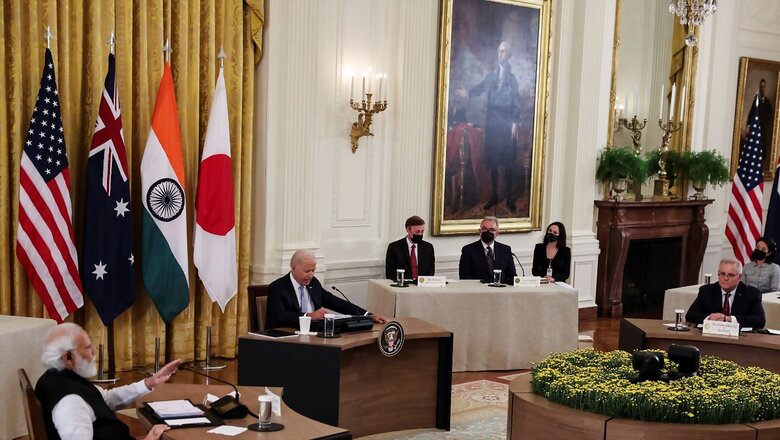
views
The third Quad summit on May 24 in Tokyo is taking place under the shadow of the conflict in Ukraine. The US/EU/Nato are all consumed by this conflict, to the exclusion of almost everything else.
The West is attempting to create a global front against Russia, even going as far as both appealing to and threatening China to not support Russia economically or militarily. India too has come under pressure to condemn Russia for its aggression against Ukraine, reduce its military ties with Russia, not violate the sanctions imposed on the country by the West and, specifically, not buy discounted Russian oil or make payment through a rupee-rouble arrangement. All-out pressure on India has, however, not been applied because of the almost indispensable role of India in any viable Indo-Pacific strategy of which Quad is one concrete face.
During his recent visit to Europe – which is in the eye of the Ukraine storm – Prime Minister Narendra Modi managed to maintain India’s independent position on Ukraine without affecting the positive forward movement in India-Europe ties. That Modi had a successful summit with Nordic countries, when two of them – Finland and Sweden – were already preparing to shed their traditional neutrality and apply for Nato membership, speaks a lot about the growing recognition in Europe – and by extension the West – of the need to accommodate India geopolitically to some extent.
This suggests that despite President Biden having described India’s position on Ukraine within the Quad as shaky, India will be able to stand its ground in Tokyo. In the joint statements with Denmark, the Nordic countries and France, the difference in respective positions on Ukraine appeared, with the European side stating its own condemnatory position on Russia separately and the consensus paragraph accommodating India’s evolved position. It is reasonable to assume that even with the US present in Tokyo, India will be able to retain the language it accepted during Modi’s European visit.
ALSO READ | ‘With Us or Against Us’ is Outdated, the Quad Will Benefit from India-Russia Ties
China and Beyond: The Quad Agenda
This does not mean that the US will not continue within Quad and outside to push for a change in India’s position on Ukraine as part of a larger effort to draw India closer to the West. Kurt Campbell, the White House’s coordinator for the Indo-Pacific, in a speech to the Washington-based Centre for Strategic and International Studies on May 9, emphasised the administration’s coordination with Europe to this end. “One of the things that is clearly underway between the United States and Europe is a desire to engage more fundamentally India,” he said. “In this new strategic context, India in many respects is a swing state, and … it is in all of our best interests to try to work over time to bend its trajectory more to the West.”
In February this year, the US announced its policy of supporting “India’s continued rise and regional leadership”, delivering the “tremendous” potential and promise of Quad, and promoting “open, resilient, secure, trustworthy tech, including 5G, Open RAN and cuber capacity”. Interestingly, the US said that it saw its China strategy as “global in scope”, and “Indo-Pacific as a particularly intense region of competition”.
It will detract from the purpose and cohesion of the Quad if issues outside the Indo-Pacific are brought on the agenda. The Quad was never intended as a counter to Russia in the Indo-Pacific region. Russia is no doubt an Indo-Pacific power geographically, politically and militarily. It is part of Asia-Pacific Economic Cooperation (APEC), has a naval fleet in Vladivostok, and a territorial dispute with Japan over sovereignty of the Kuril Islands. It has military ties with some ASEAN countries in the way of arms supplies, it has traditional political and military ties with Vietnam in particular. In October 2021, it has done maritime drills with China for the first time in the western Pacific, circling around Japan’s main Honshu island.
However, the genesis and evolution of Quad have all to do with China’s activities in the South and East China Seas, its militarisation of islands in the South China Sea and asserting illegal sovereignty claims in the western Pacific in violation of the UN Convention on the Law of the Sea (UNCLOS). Beyond that, the Quad has a much wider agenda that spans other challenges that China presents, including those that came to the fore during the pandemic relating to over dependence on China for critical supply chains and raw materials, China weaponising them for political reasons, its dual use connectivity projects under its humongous Belt and Road Initiative, and the challenges that China presents in the areas of critical technologies such as Artificial Intelligence, quantum computing, semiconductors, 5G and 6G etc. All these diverse issues figure on the Quad agenda, including climate change, anti-COVID vaccines, illegal fishing, disaster relief, connectivity etc., for which three working groups in specific areas were set up at a previous summit.
The Quad Report Card
The summit will no doubt assess the progress made in the implementation of its agenda. The report card does not seem impressive. The plan to produce 1 billion doses of Johnson and Johnson vaccine in India for the Indo-Pacific countries has not progressed sufficiently, and the prospects do not look bright as the issue of vaccine shortages in this region seems to have been largely addressed, besides some issues in the US with the FDA approvals for this American vaccine in question.
On technology issues no quick results can be achieved. India is intent on developing domestic capacity to make semiconductors. It is to be seen what push the Quad can give to this ambition, as well as in other identified advanced technology areas for which private sector collaboration will be key, with government facilitation in terms of incentives, regulatory processes etc. The AUKUS agenda also covers some of the high technology areas that are on the Quad agenda, which may cast doubt on which forum will be given priority. However, India’s impressive capabilities in the IT sector which can be leveraged in the shared interest of the Quad countries as well as the country’s massive digitalisation programme would make India an attractive partner.
It is likely that at the Quad summit the issue of global food security following the Ukraine crisis will be raised. The US has already announced that it will discuss this issue in the UN Security Council and persuade India to permit wheat exports.
The larger question is how much attention the US can realistically pay to the Indo-Pacific and the Quad given the priority it is attaching to its confrontation with Russia. While the US is announcing that it has the capacity to deal with the threats from Russia and China at the same time, pointing to the organisation of US-ASEAN summit in Washington, Biden’s visit to East Asia and the convening of the Quad summit as evidence, the prolongation of the Ukrainian crisis will test the US capacities to sustain two fronts.
The US believes that the power of its draconian sanctions on Russia has been demonstrated and China cannot but note it as its dependence on western markets and finance is much larger that Russia’s and it has much more to lose in a confrontation with the West. That Germany, the biggest partner of China in Europe, has been brought to heel on Russia signals that with the changing mood on China in Europe, Germany too can be pressured on its China ties. The US also seems to think that the US/EU/Nato reaction to Russia’s invasion of Ukraine will make China re-think any plans to coerce Taiwan militarily.
While the US continues to talk tough with China and the latter misses no opportunity to hit back, on the ground the US has reportedly already lifted 68 per cent of the tariffs imposed by Trump on Chinese exports to the US and currently there is a tussle between the Treasury Secretary to lower tariffs further to control inflation in the US and the US Trade Representative who is against this. That the US needs to appeal to China not to come to the assistance of Russia shows that its hand is not as strong as it wants to believe. The reach out to Venezuela also shows that the US is willing to make compromises to alleviate the consequences of its own punitive sanctions on Russia.
The security component of the Quad has no doubt been watered down by the emergence of the AUKUS, which will be the forum to develop a range of advanced military technologies to amplify the collective strengths of the three partner countries for deterring China. That Japan was invited to join AUKUS has been denied by the White House, but if such a move were to be made – unlikely because of the nuclear dimension of AUKUS and Japan’s pacifist constitution – it will alter the nature of Quad, even though the maritime dimension of Quad will remain, as there can be no viable Indo-Pacific strategy covering the Indian Ocean without India.
China’s success in establishing itself in the Solomon Islands has galvanised the Pacific strategy of the US. Biden addressed the Pacific Islands Forum earlier this year. Both Japan and Australia are no doubt worried at the Chinese coup in the Solomons. For India too, such Chinese successes are forerunners to more Chinese naval presence in the Indian Ocean eventually.
In October 2021, Biden announced the US intention to develop an Indo-Pacific economic framework covering trade facilitation, standards for the digital economy and technology, supply chain resiliency, decarbonisation and clean energy, infrastructure, workers standards etc. An important part of this initiative is already covered in the Quad agenda. It is clear that discussions within the Quad cannot be isolated from this more ambitious US agenda, significant parts of which in India’s thinking should be part of WTO discussions and some should not be linked to trade issues. India’s outlook on the Quad agenda in these areas will need to be adjusted accordingly.
The Ukraine crisis has churned global geopolitics as almost never before since the demise of the Soviet Union, with implications also for the Quad.
ALSO READ | India Must Lead Quad Effort to Pull Out Sri Lanka from Clutches of China’s Debt Trap Diplomacy
Kanwal Sibal is former Indian Foreign Secretary. He was India’s Ambassador to Turkey, Egypt, France and Russia. The views expressed in this article are those of the author and do not represent the stand of this publication.
Read all the Latest Opinions here




















Comments
0 comment